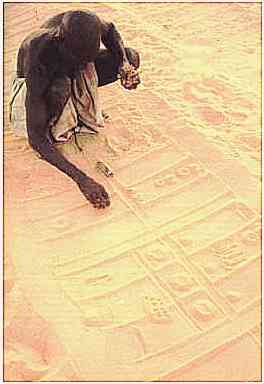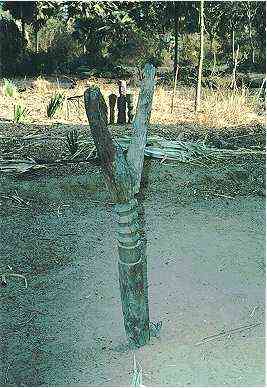
The infancy of Edward Shelonga Part 0
an extended case study in medical and religious anthropology from the Zambia Nkoya: Abstract and links to other parts
Wim van Binsbergen

 |
The infancy of Edward Shelonga Part 0 an extended case study in medical and religious anthropology from the Zambia Nkoya: Abstract and links to other parts Wim van Binsbergen |
 |
First
published in: van der Geest, J.D.M., & van der Veen, K.W.,
1979, eds., In search of health: Essays in medical anthropology,
Amsterdam: Antropologisch Sociologisch Centrum, pp. 19-90
to Part I (Problem and Method;
Background)
Part
II (The extended case; Ethics)
Part
III (Interpretation; Conclusion)
Part
IV (References; Postscript on Cognition)
for a simple downloadable TXT version of this extensive medico-religious study, click here
for Henny
1. Abstract
In
this article I shall present a case history based on the health
experiences of a Zambian boy in the first years of his life. The
reason for publishing this case is that it sheds some light on
one of the crucial medical problems of the Third World: the
interplay between cosmopolitan (i.e. western, modern) medicine,
and such other forms of medicine as exist locally; the latter
forms usually are part and parcel of the local religion. Use is
made of the ‘extended-case method’, which sees in the
relationships between people within one social field, and in the
evolvement of these relationships over time, the major key to
structural principles, in casu those governing the interplay
between the various forms of medicine.
In section 2, I introduce the problem, and the method by which I
shall approach it. The next section gives some background data
(medical, social-structural, cultural) without which the case
cannot be understood. In section 4, I present the case history.
In the next section I examine the researchers roles in the case,
which were so crucial that the story might be considered a
research artifact. Having demonstrated that the case is not thus
contaminated, I proceed in section 6 to outline the structural
principles that can be derived from the case history, as they
apply to the specific social setting of Zambian peasants and
urban poor belonging to the Nkoya ethnic minority.
Although displaying a seemingly irrational movement to and fro
between cosmopolitan and Nkoya medicine, the health behavior of
the people involved in the case will be shown to be rational and
understandable in the light of the following principles:
— Health choices are made not only on the basis of cognitive
elements (beliefs, concepts concerning health and disease), but
also on the basis of an evolving social process, in which social
relationships (including those with health agents) develop and
their effects (in the form of positive and negative experiences
and expectations) accumulate.
— Given the indeterminate, ephemeral, extremely flexible
nature of Nkoya social groups, the social process among this
people revolves around continuous shifts in social relationships,
through which individuals try to maximize social, political,
ritual and medical support; in this light it is understandable
that people pursue both cosmopolitan and Nkoya medicine, but the
extent to which they do so depends on the quality of the evolving
social relationships through which they get access to either
source of health care.
— Kinship and marriage, and the authority relations defined
by these institutions, set the internal constraints for the
social process within Nkoya society, and thus largely determine
when and why younger people have to submit to the health actions
which the elders are continuously imposing upon them.
— For those Nkoya who participate in the multi-ethnic urban
environment, modern-sector employment as well as personal
relationships and experiences with agents of cosmopolitan
medicine largely determine the extent to which cosmopolitan
health care is utilized.
— Most Nkoya (and many other African urban migrants) are in
a peculiar socio-economic position. They participate in urban
capitalist structures but their ultimate socio-economic security
rests in the village, not primarily because of the so-called
‘force of tradition’, but because the political
economic of this part of the world has assigned to the village
the task of reproducing cheap labor and accommodating discarded
labor. Remaining dependent upon the village, even those Nkoya who
are committed supporters of cosmopolitan medicine have to abide
by the institutions of their rural society, including the medical
role of the elders, through which authority is asserted, the
group affiliations of junior members are manipulated, and
town-earned money is channeled to the village.
Note: This paper is a product of my research into religious change and urban-rural relations in Zambia, in which I have been engaged since 1972. Field-work was undertaken alternatingly in Lusaka and Western province, Zambia, from February 1972 to April 1974, from September to November 1977 and in August 1978. A research grant from the University of Zambia covered initial research expenses in the period February-April 1972. In 1973-74 and 1977-78 I was a Research Affiliate of the University of Zambia's Institute for African Studies, in which capacity I greatly benefitted from the intellectual exchange and research facilities offered. The Netherlands Foundation for the Advancement of Tropical Research (WOTRO) provided a writing-up grant for the period 1974-75, when the first draft of the present paper was prepared for the 11th International Course in Health Development, Royal Tropical Institute, Amsterdam, April 1975. The final version was written under the stimulating conditions of my current appointment as Research Officer at the African Studies Centre, Leiden; this institution also financed my 1977 and 1978 research trips. While registering my indebtedness and gratitude vis-\'e0-vis these various institutions, the Zambian authorities and my informants, I wish to thank in particular the following people: Henny van Rijn, my ex-wife, with whom I shared the traumatic experience of studying the Nkoya medical situation, and to whom consequently this paper is dedicated; Muchati and his wife Mary for reasons which my argument will make sufficiently clear; D.G. Jongmans for offering me the opportunity of presenting my data and views before a medical audience; the students of the International Course in Health Development, to whose passionate and incisive discussion the argument owes a great deal; J. Vosters, sometime medical officer in charge of a hospital in Western Zambia, to whose constant advise and supervision we, as medical laymen, owe much of our clinical experience with the rural medical situation; the District Medical Officer, Kaoma district, who actively encouraged the medical line in our research; J. Kee, sometime medical officer in charge of a hospital in Western Zambia, for adding to our understanding of the area's medical situation and medical history; S. van der Geest, K.W. van der Veen and H.C.F. Zwaal (M.D.) for detailed comments on earlier drafts of this paper; and finally the members of the Leiden Africa Seminar whose discussion of an earlier version of the paper was most helpful.
to Part I (Problem and Method; Background)
Part II (The extended case; Ethics)
Part III (Interpretation; Conclusion)
Part IV (References; Postscript on Cognition)
| page last modified: 12-02-01 09:26:10 |  |
|||
 |